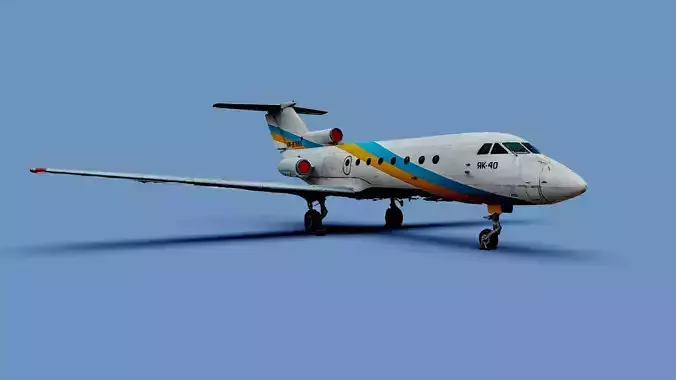1/20
Raw scan by photogrammetry technology
.obj .gltf .usdz
The Yak-40 is the world’s first jet aircraft for local airlines (up to 1,500 km long). Its serial production began in the 60s of the 20th century. The plane can accommodate from 27 to 32 passengers. Can take off and land on dirt airfields. Modifications of the Yak-40 are still used today by airlines of a number of countries, including Ukraine.
The Yak-40, hailed as the world's first jet aircraft designed for local airlines, holds a significant place in aviation history. With its serial production commencing in the 1960s, this remarkable aircraft revolutionized regional air travel. Capable of accommodating between 27 to 32 passengers, the Yak-40 possessed the versatility to operate on both conventional and dirt airfields. Even today, various modifications of this iconic aircraft continue to serve the aviation needs of several countries, including Ukraine. In this description, we explore the raw scan of the Yak-40 created through the advanced technique of photogrammetry, capturing its distinctive features and celebrating its enduring legacy.
The Yak-40's historical significance lies in its pioneering role as the first jet aircraft specifically designed for local airline operations. In an era dominated by larger jetliners, the Yak-40 filled a crucial niche by providing efficient air travel solutions for shorter distances, typically up to 1,500 kilometers. This innovative design opened up new possibilities for regional air transportation, greatly enhancing connectivity and accessibility for smaller cities and towns.
Designed to cater to the needs of local airlines, the Yak-40 could comfortably accommodate between 27 to 32 passengers. This optimal seating capacity struck a balance between operational efficiency and passenger comfort, making it an ideal choice for regional routes. Furthermore, the aircraft's ability to take off and land on dirt airfields expanded its operational range, allowing it to serve areas with limited infrastructure and providing vital connections to remote locations.
Through the employment of photogrammetry technology, a raw scan of the Yak-40 has been meticulously created. This cutting-edge technique involves capturing a multitude of high-resolution photographs from various angles, which are then processed to reconstruct a detailed 3D model of the aircraft. The raw scan, a digital representation of the aircraft's exterior, faithfully captures the precise geometry and visual characteristics of the Yak-40, ensuring an accurate representation of its physical form.
The Yak-40 possesses distinct design features that contribute to its timeless appeal. Its streamlined fuselage, complemented by a sleek nose and a trio of jet engines mounted on the rear, embodies a classic aesthetic. The aircraft's low-wing configuration, characterized by the engines' placement beneath the wings, enhances stability and provides efficient lift during takeoff and landing. These design elements, coupled with its compact size, make the Yak-40 instantly recognizable and distinguishable from other aircraft of its era.
While several decades have passed since the Yak-40's initial production, its enduring legacy continues to be felt in the aviation industry. Modified versions of this remarkable aircraft remain in service, enabling regional airlines in various countries, including Ukraine, to provide reliable and efficient air travel options. The Yak-40's long-standing presence attests to its robust design, operational versatility, and ability to adapt to the evolving needs of local air transportation.
The raw scan of the Yak-40, created through the remarkable process of photogrammetry, pays homage to the world's first jet aircraft designed for local airlines. Its historical significance, optimal passenger capacity, and versatility in operating on dirt airfields contributed to its iconic status. This raw scan, capturing the aircraft's distinctive design features, serves as a testament to its enduring legacy in regional aviation. As we explore this digital representation, we are reminded of the Yak-40's role in enhancing connectivity, expanding accessibility, and shaping the evolution of local air travel.
REVIEWS & COMMENTS
accuracy, and usability.




















